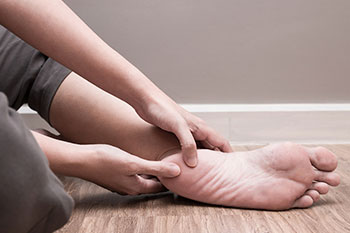Town Square Family Foot Care has permanently closed.
Dr. Scholz has accepted a position as a Podiatrist in the Department of Orthopedics and Rehabilitation at University of Iowa Health Care. If you’d like to schedule an appointment, call 319-356-2223.
If you would like to have your records sent to another provider, please send a record release form found on our website, 341foot.com, to our secure email contactus@341foot.net.
Fat Pad Replacement

What is Fat Pad Atrophy?
Plantar fat pads are thick, cushioning pads of connective tissue located under the heel and ball of the foot. Fat pad atrophy occurs when these pads break down and thin out due to age or other factors.
Normal plantar fat pads are typically 1-2 cm in thickness. Fat pad atrophy can cause fat pads to reduce to less than 1 cm, which prevents them from providing shock absorption, weight distribution and cushioning for the feet.
Causes of Fat Pad Atrophy
The most common reason for fat pads to break down is age. Like other fat pads in the body, plantar fat pads will gradually shrink and separate. Also, gravity will cause them to drop down over time and lose their fullness, making them a common ailment among the elderly.
There are other possible causes of fat pad atrophy such as:
- Genetics
- Improper footwear or high heels that shift the body’s center of gravity and create repeated stress on the balls of the feet and heels
- Walking barefoot
- Engaging in high-impact activities
- Complications due to rheumatoid arthritis, diabetes, or neuropathy
- A previous injury or surgery that causes damage to, or displacement of, the fat pad tissue
- Gait abnormalities
- High arches
- Chronic steroid use
Symptoms of Plantar Fat Pad Atrophy
Plantar fat pad atrophy can be very painful, especially when wearing high heels or thin-soled footwear, walking on hard surfaces while barefoot, or having to stand for long periods of time. Left untreated, fat pad atrophy may also cause:
- Inflammation/li>
- Damage to nerves, ligaments and bones.
- The feeling of a stone being stuck in the front of the shoe
- Painful calluses
- Ulcers deep in tissue below the skin’s surface
- Painful bones or fractured bones
Plantar Fat Pad Atrophy Treatments
Fat Pad Atrophy can be treated by a podiatrist through changes in footwear, lifestyle, or with clinical procedures to restore cushioning in the fat pads.
Changes in Footwear and Lifestyle: Shoes should fit properly, have support in the heel and ball of the foot, and not be too narrow or high. Your podiatrist may also make up for the lack of cushioning and weight distribution by prescribing custom orthotics to be worn inside shoes.
Your podiatrist may also suggest changes in lifestyle such as encouraging you to modify high-impact activities, or not walking barefoot.
Clinical Fat Pad Restoration: There are a variety of Injectable filler materials your podiatrist can use to increase the volume and cushioning in the ball of the foot and heel. Many patients report comforting relief right away with these injectable solutions, depending on how badly deteriorated the fat pads are. This is a minimally invasive procedure with little-to-no side effects or downtime.
If you believe you may have fat pad atrophy, make an appointment with your podiatrist for a full evaluation and to discuss your treatment options.